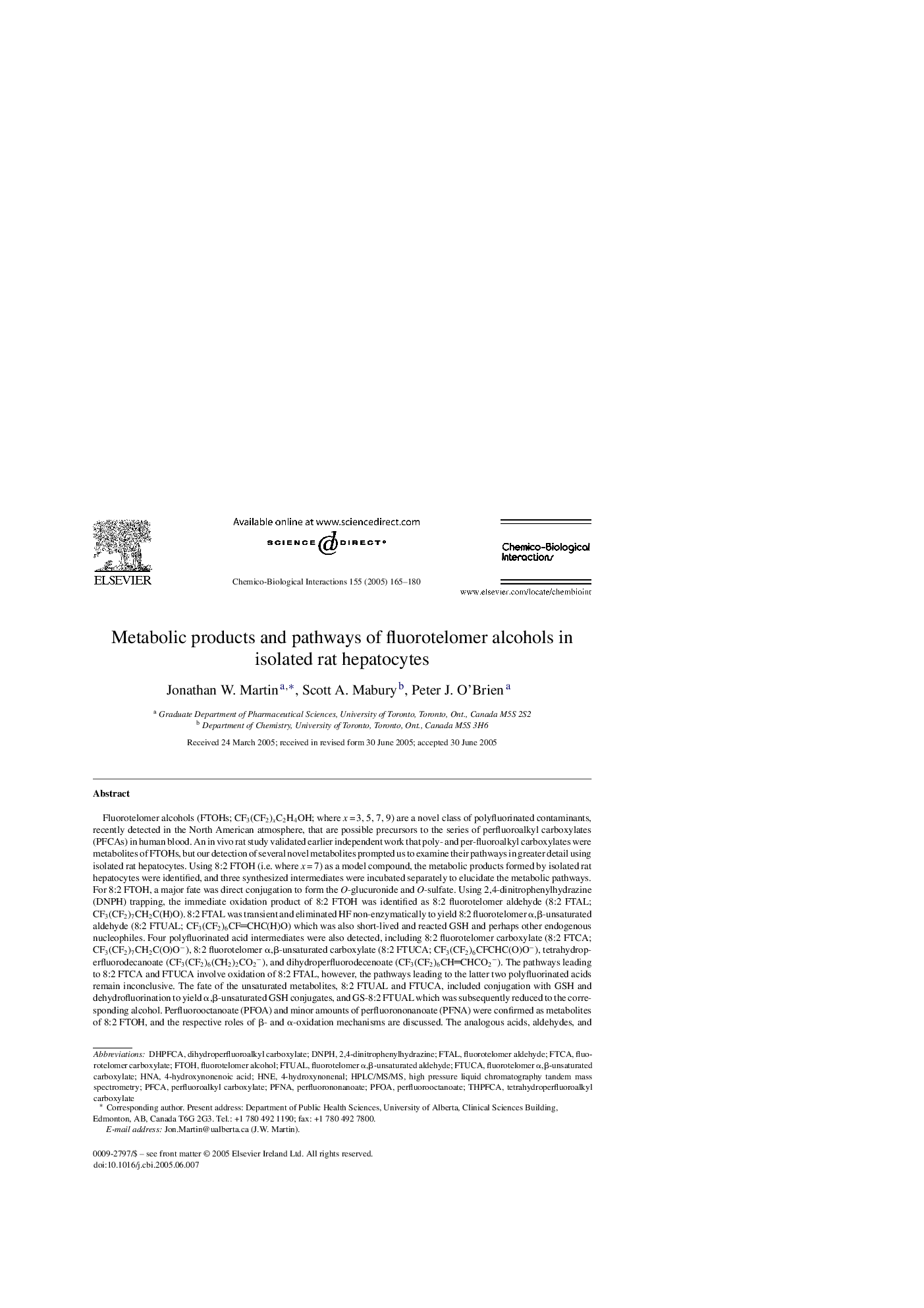| Article ID | Journal | Published Year | Pages | File Type |
|---|---|---|---|---|
| 9029454 | Chemico-Biological Interactions | 2005 | 16 Pages |
Abstract
Fluorotelomer alcohols (FTOHs; CF3(CF2)xC2H4OH; where x = 3, 5, 7, 9) are a novel class of polyfluorinated contaminants, recently detected in the North American atmosphere, that are possible precursors to the series of perfluoroalkyl carboxylates (PFCAs) in human blood. An in vivo rat study validated earlier independent work that poly- and per-fluoroalkyl carboxylates were metabolites of FTOHs, but our detection of several novel metabolites prompted us to examine their pathways in greater detail using isolated rat hepatocytes. Using 8:2 FTOH (i.e. where x = 7) as a model compound, the metabolic products formed by isolated rat hepatocytes were identified, and three synthesized intermediates were incubated separately to elucidate the metabolic pathways. For 8:2 FTOH, a major fate was direct conjugation to form the O-glucuronide and O-sulfate. Using 2,4-dinitrophenylhydrazine (DNPH) trapping, the immediate oxidation product of 8:2 FTOH was identified as 8:2 fluorotelomer aldehyde (8:2 FTAL; CF3(CF2)7CH2C(H)O). 8:2 FTAL was transient and eliminated HF non-enzymatically to yield 8:2 fluorotelomer α,β-unsaturated aldehyde (8:2 FTUAL; CF3(CF2)6CFCHC(H)O) which was also short-lived and reacted GSH and perhaps other endogenous nucleophiles. Four polyfluorinated acid intermediates were also detected, including 8:2 fluorotelomer carboxylate (8:2 FTCA; CF3(CF2)7CH2C(O)Oâ), 8:2 fluorotelomer α,β-unsaturated carboxylate (8:2 FTUCA; CF3(CF2)6CFCHC(O)Oâ), tetrahydroperfluorodecanoate (CF3(CF2)6(CH2)2CO2â), and dihydroperfluorodecenoate (CF3(CF2)6CHCHCO2â). The pathways leading to 8:2 FTCA and FTUCA involve oxidation of 8:2 FTAL, however, the pathways leading to the latter two polyfluorinated acids remain inconclusive. The fate of the unsaturated metabolites, 8:2 FTUAL and FTUCA, included conjugation with GSH and dehydrofluorination to yield α,β-unsaturated GSH conjugates, and GS-8:2 FTUAL which was subsequently reduced to the corresponding alcohol. Perfluorooctanoate (PFOA) and minor amounts of perfluorononanoate (PFNA) were confirmed as metabolites of 8:2 FTOH, and the respective roles of β- and α-oxidation mechanisms are discussed. The analogous acids, aldehydes, and conjugated metabolites of 4:2, 6:2, and 10:2 FTOH (i.e. where x = 3, 5, and 9, respectively) were also detected, and metabolite profiles among FTOHs generally differed only in the length of their perfluoroalkyl chains. Preincubation with aminobenzotriazole, but not pyrazole, inhibited the formation of metabolites from all FTOHs, suggesting that their oxidation was catalyzed by P450, not alcohol dehydrogenase.
Keywords
Related Topics
Life Sciences
Environmental Science
Health, Toxicology and Mutagenesis
Authors
Jonathan W. Martin, Scott A. Mabury, Peter J. O'Brien,
